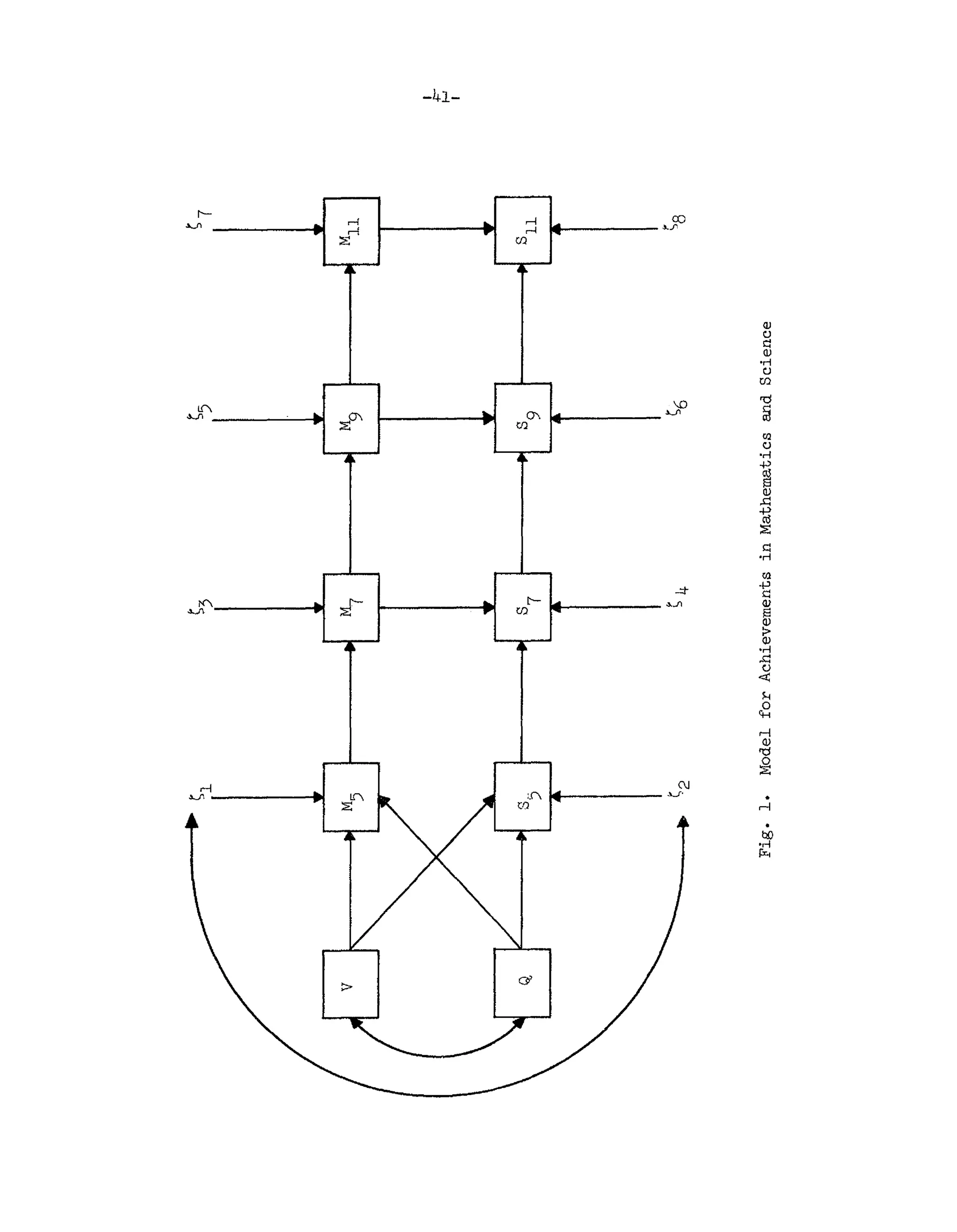This document presents a general method for estimating unknown coefficients in linear structural equation systems, accommodating both errors in equations and errors in variables. The method allows for the computation of residual variance-covariance matrices and measurement error variances, and it includes an illustrative application to economic and psychological data. Additionally, it discusses two special cases involving either errors in equations or errors in variables and outlines the numerical methods and assumptions used for estimation.
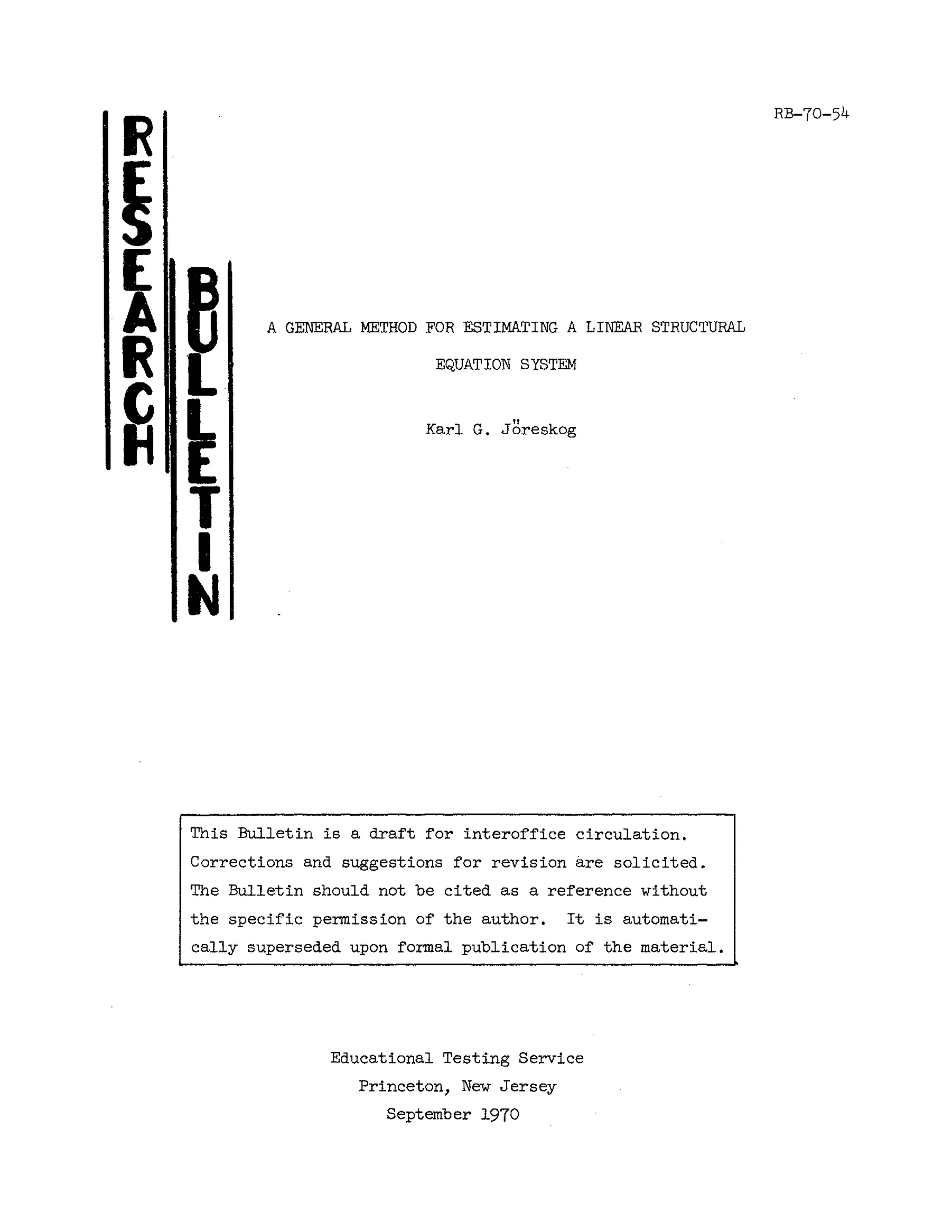
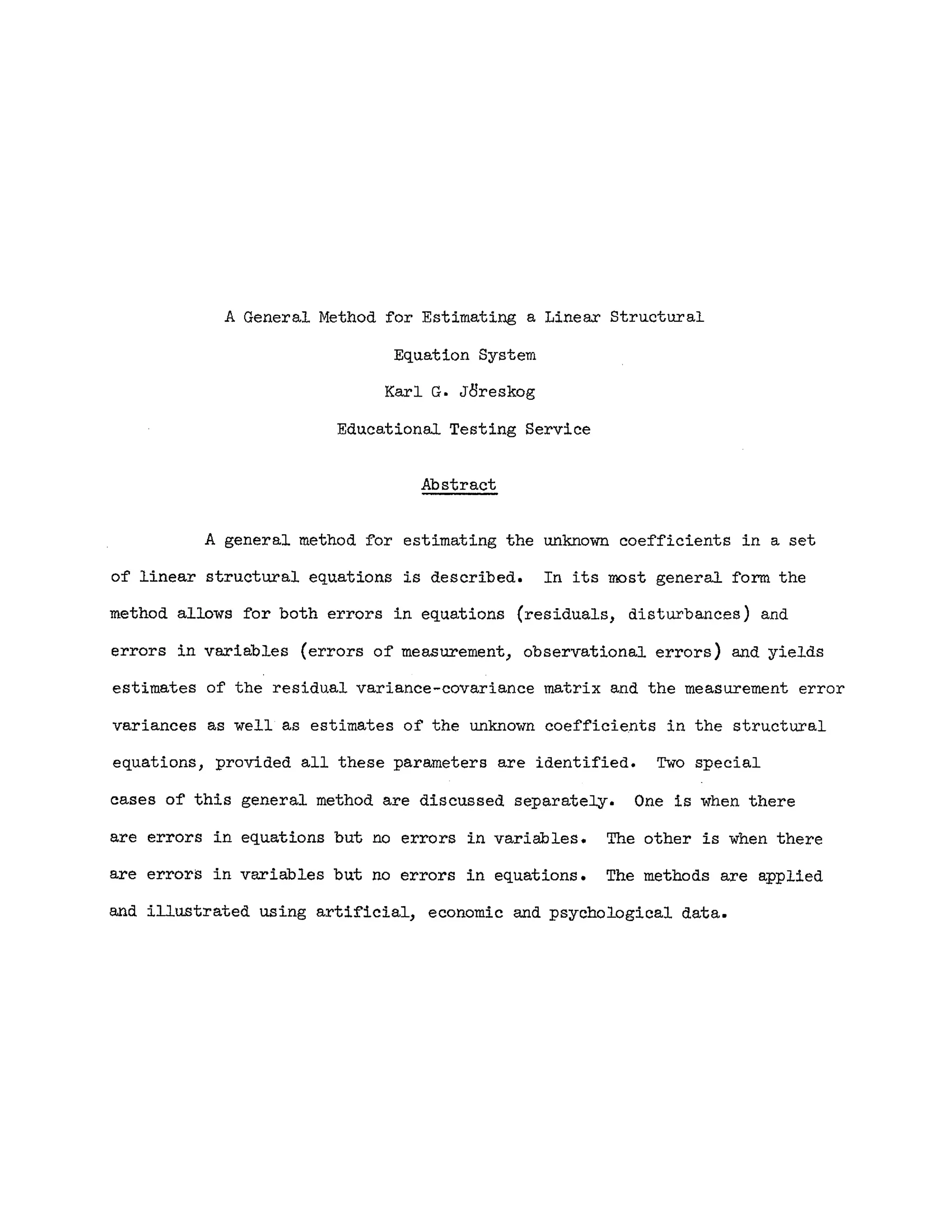
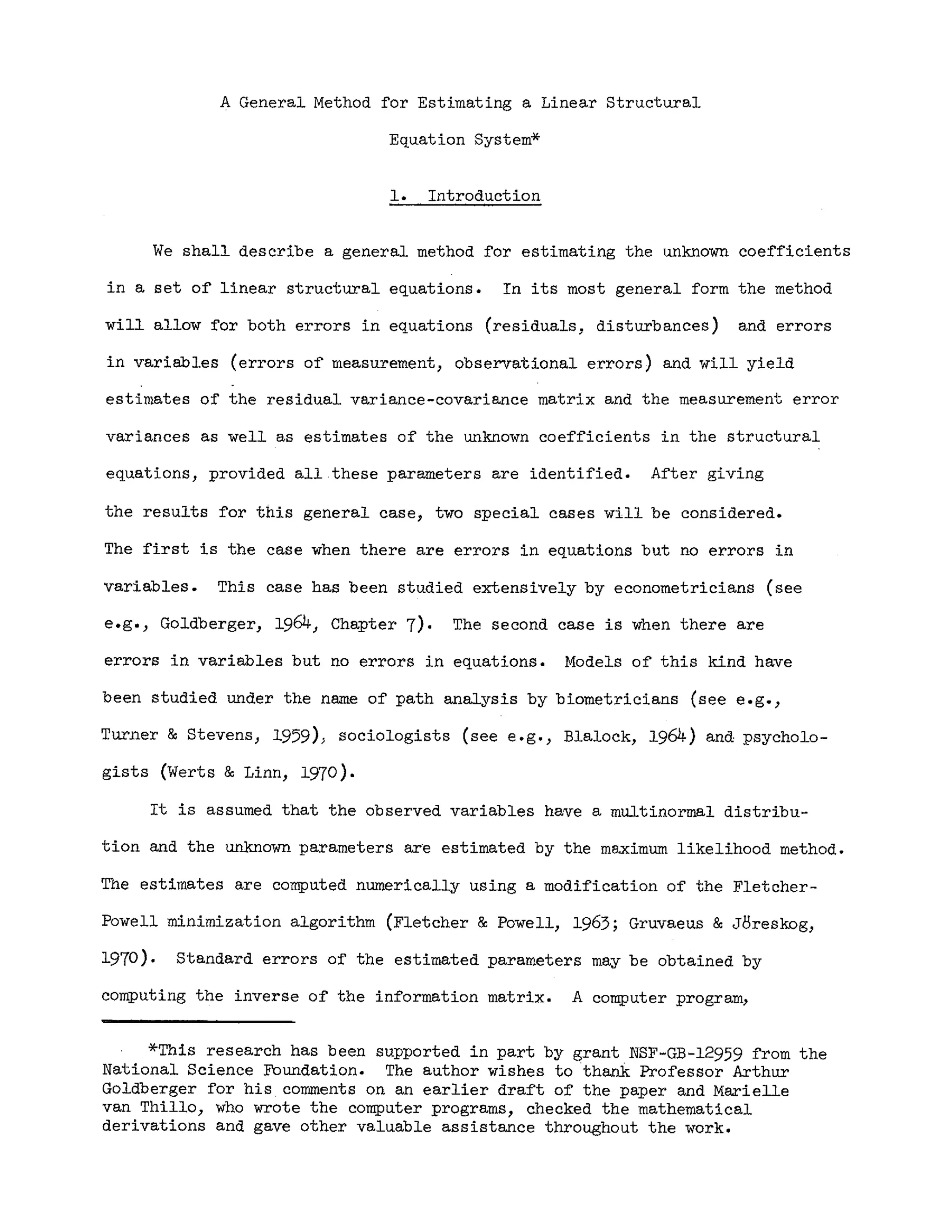

![-3-
The vectors ~ and e are not observed but instead vectors yl =
(Yl'Y2'·"'Ym) and Xl = (xl,x2, ... ,x
n)
are observed, such that
Y (2)
x=v+~+5
where I-l = ,e(y) v = e(~) and E and 5 are vectors of errors of measure-
ment in y and ~, respectively. It is convenient to refer to y and x
as the observed variables and ~ and s as the true variables. The errors
of measurement are assumed to be uncorrelated with the true variates and
among themselves.
Let p(n x n) and
and s} respectively,
be the variance-covariance matrices of
8
2
the diagonal matrices of error
_5
variances for y and ~, respectively. Then it follows, from the above
assumptions, that the variance-covariance matrix E[(m + n) x (m + n)] of
z = (y"::5 r )' is
(4)
~-l~~1~1-l
E =f -
~::.~.-l
The elements of E are functions of the elements of B} r, ¢, ~,
and 8 .
~E
In applications some of these elements are fixed and equal
to assigned values. In particular this is so for elements in B
- and I' '
but we shall allow for fixed values even in 'the other matrices. For the
remaining nonfixed elements of the six parameter matrices one or more subsets
may have identical but unknown values. Thus parameters in B, E', p,
0/ , and s
~E
are of three kinds: (i) fixed parameters that have been](https://image.slidesharecdn.com/j-210629033234/75/A-General-Method-for-Estimating-a-Linear-Structural-Equation-System-5-2048.jpg)
![-4-
assigned given values, (ii) constrained parameters that are unknown but equal
to one or more other parameters and (iii) free parameters that are unknown and
not constrained to be equal to any other parameter.
Before an attempt is made to estimate a model of this kind, the identi-
fication problem must be examined. The identification problem depends on
the specification of fixed, constrained and free parameters. Under a given
specification, a given structure ~' r} ~, t, ~5} (3 generates
-€
one and only one ~ but there may be several structures generating the
same ~. If two or more structures generate the same ~, the structures
are said to be equivalent. If a parameter has the same value in all equiva-
lent structure~ the parameter is said to be identified. If all parameters
of the model are identified, the whole model is said to be identified. When
a model is identified one can usually find consistent estimates of all its
parameters. Some rules for investigating the identification problem when
there are no errors in variables are given by Goldberger (1964, pp. 306-318).
3. Estimation of the General Model
Let ~1'~2' ···}~N be N observations of z = (~t}~t)J • Since no
constraints are imposed on the mean vector (~t,yr)r the maximum likelihood
ti th · · t t z = (y-', x- t ) t
es mate of 1S 1S he usual sample mean vec or •
1 N
§ = - ~ (z~ - ~)(~a - ~),
N a=l "'U
be the usual sample variance-covariance matrix, partitioned as
Let
~[(m + n) x (m + n)]
=[~yy(m x m)
S (n x m)
~xy
S (m x
~yx
S (n x
-xx
n)j
n)
(6)](https://image.slidesharecdn.com/j-210629033234/75/A-General-Method-for-Estimating-a-Linear-Structural-Equation-System-6-2048.jpg)
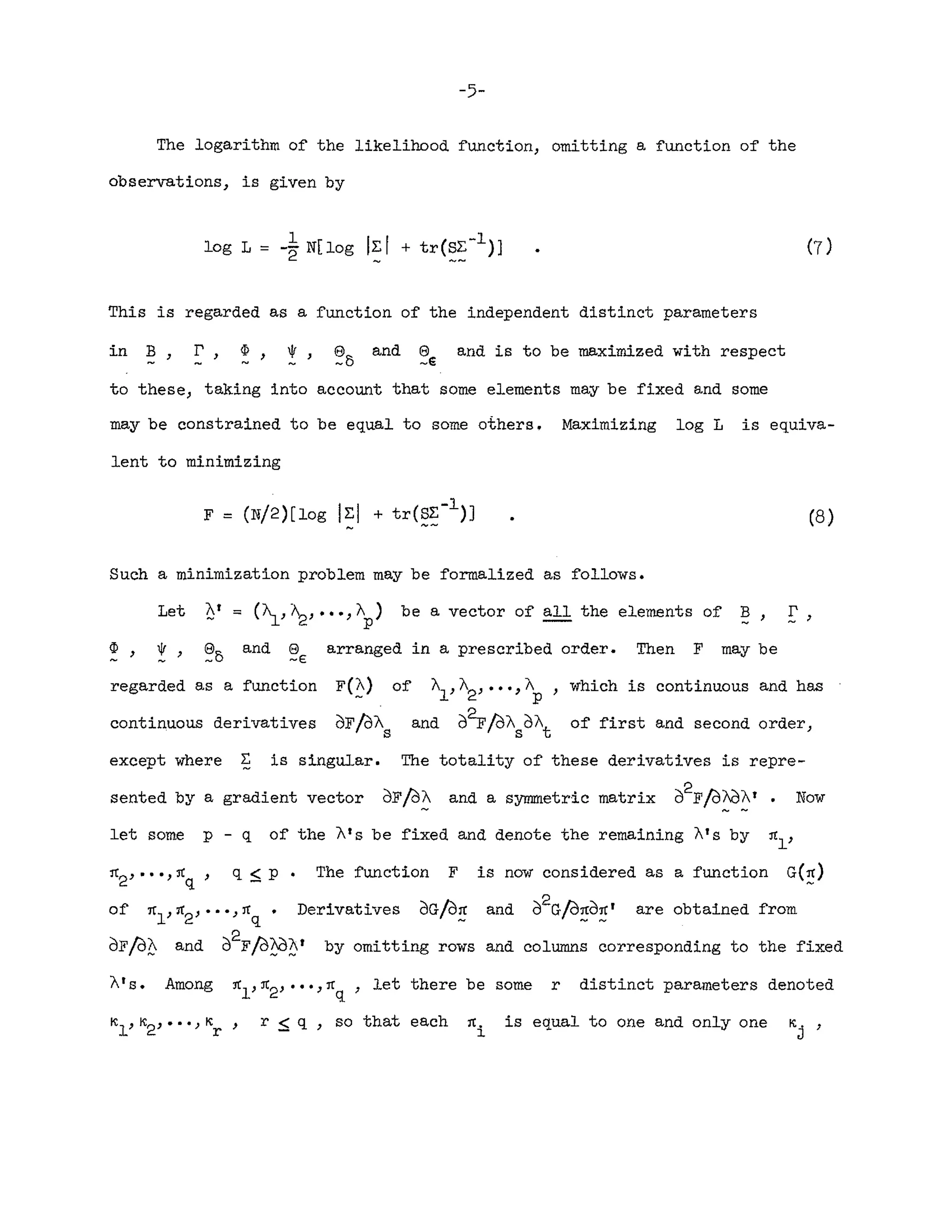

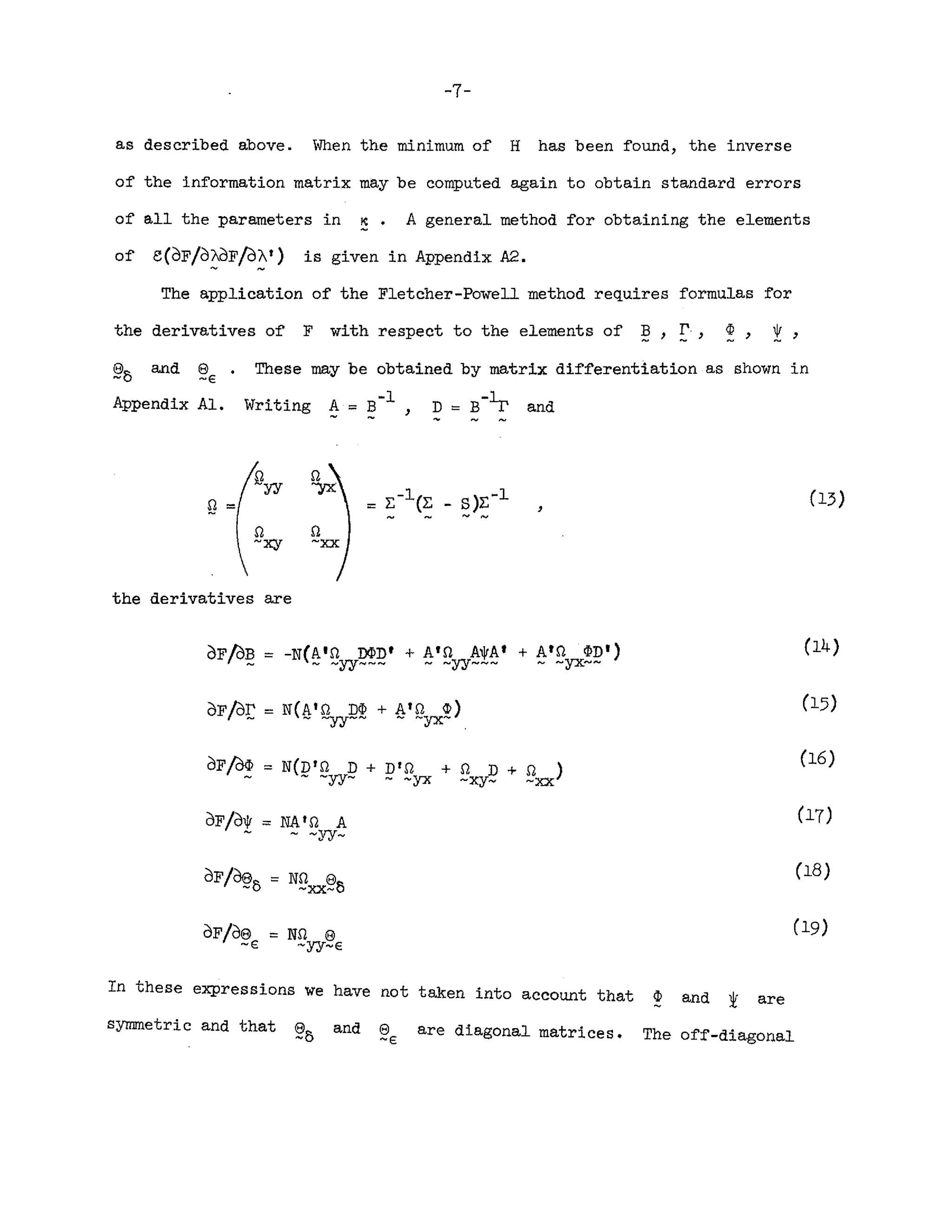
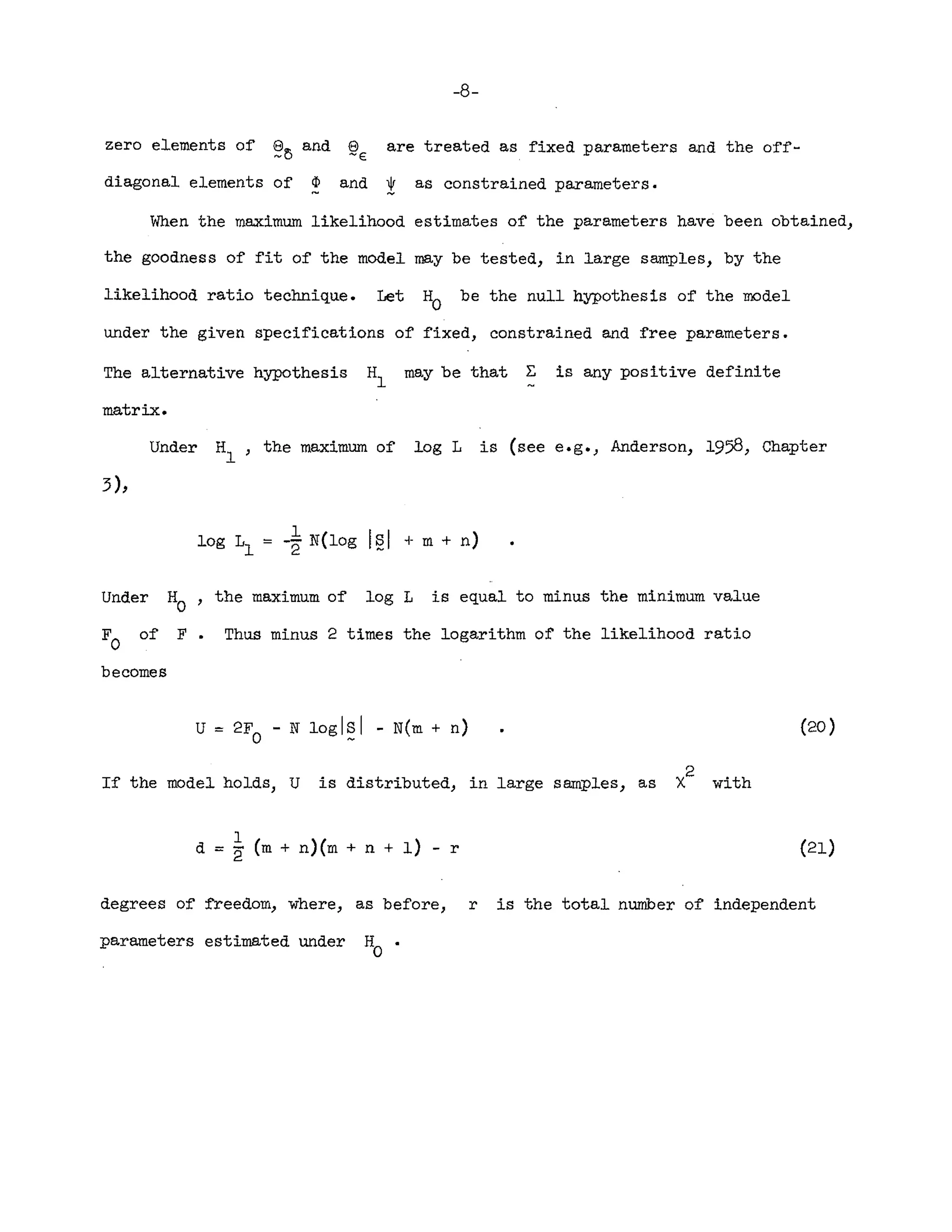

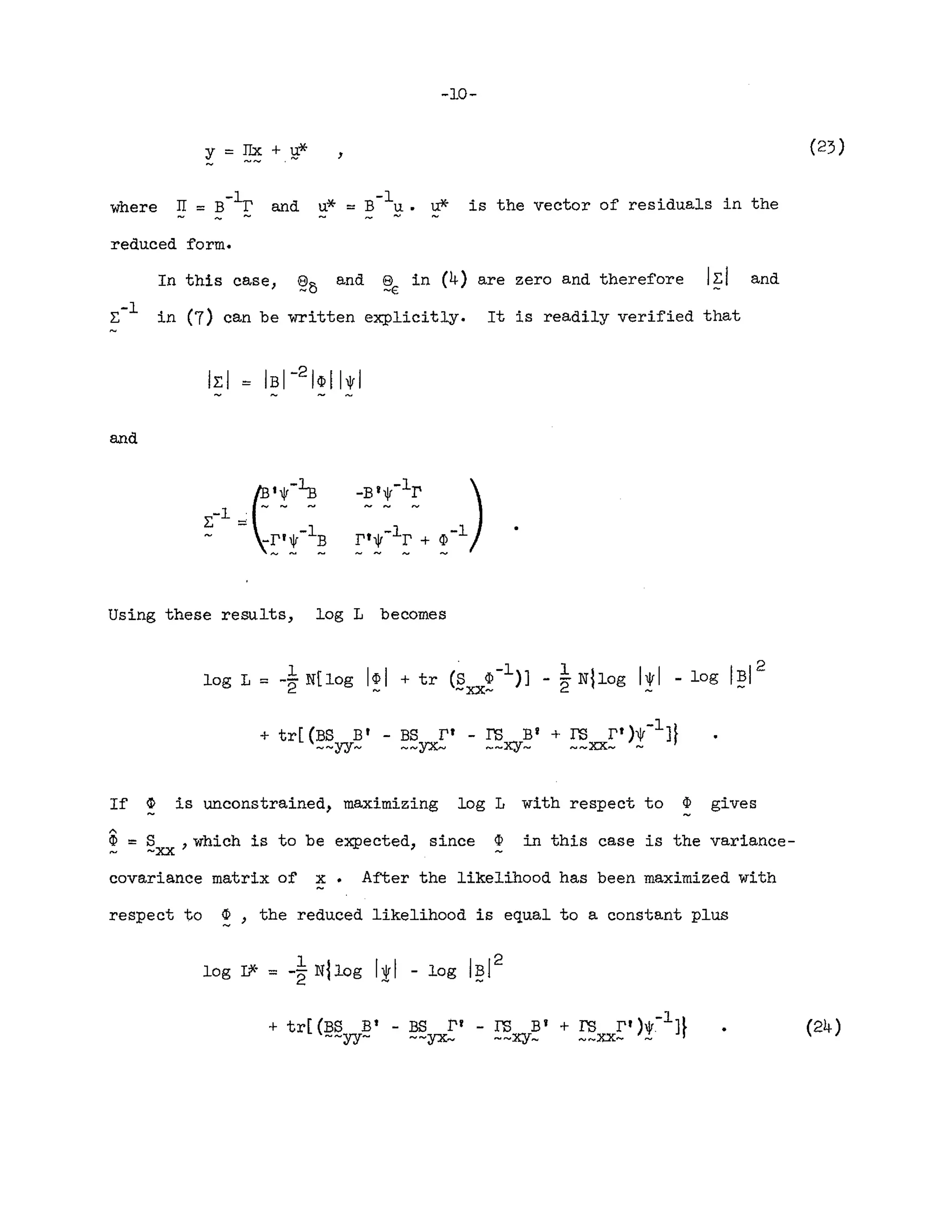
![-11-
If also * is unconstrained, further simplification can be obtained,
for then (24) is maximized with respect to *, for given Band!.:,
when 1V is equal to
,
so that the function to be maximized with respect to B and r becomes a
constant plus
log L** == -~ N[ log I~rI - log IBI2
]
1
log( I * I / IB1
2
)
== -"2 N
- -
== _IN log IB-l*Bt -11
2 - --
where
, (26)
1r*== S
-yy
- S II' - lIS + lIS II'
-yx- --xy __xx_
In deriving (26), we started from the likelihood function (7) based on
the assumption of multinormality of y- and !. Such an assumption may be
very unrealistic in most economic applications. Koopmans, Rubin and Leipnik
(1950) derived (24) and (26) from the assumption of multinormal residuals.
~ , which is probably a better assumption. However, the criterion (26)
has intuitive appeal regardless of distributional assumptions and con-
nections with the maximum likelihood method. The matrix l' in (25) is the
variance-covariance matrix of the residuals u in the structural form (22)](https://image.slidesharecdn.com/j-210629033234/75/A-General-Method-for-Estimating-a-Linear-Structural-Equation-System-13-2048.jpg)
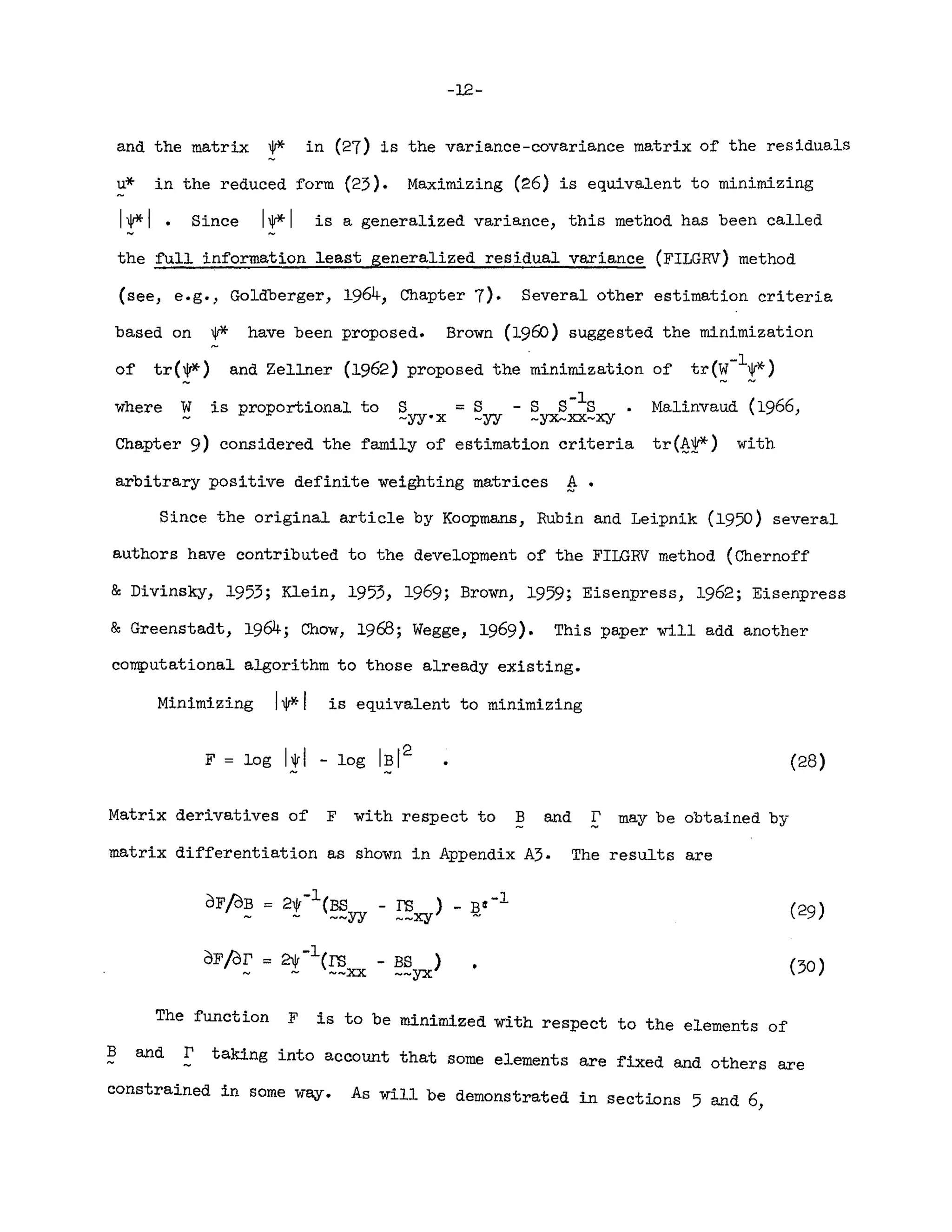
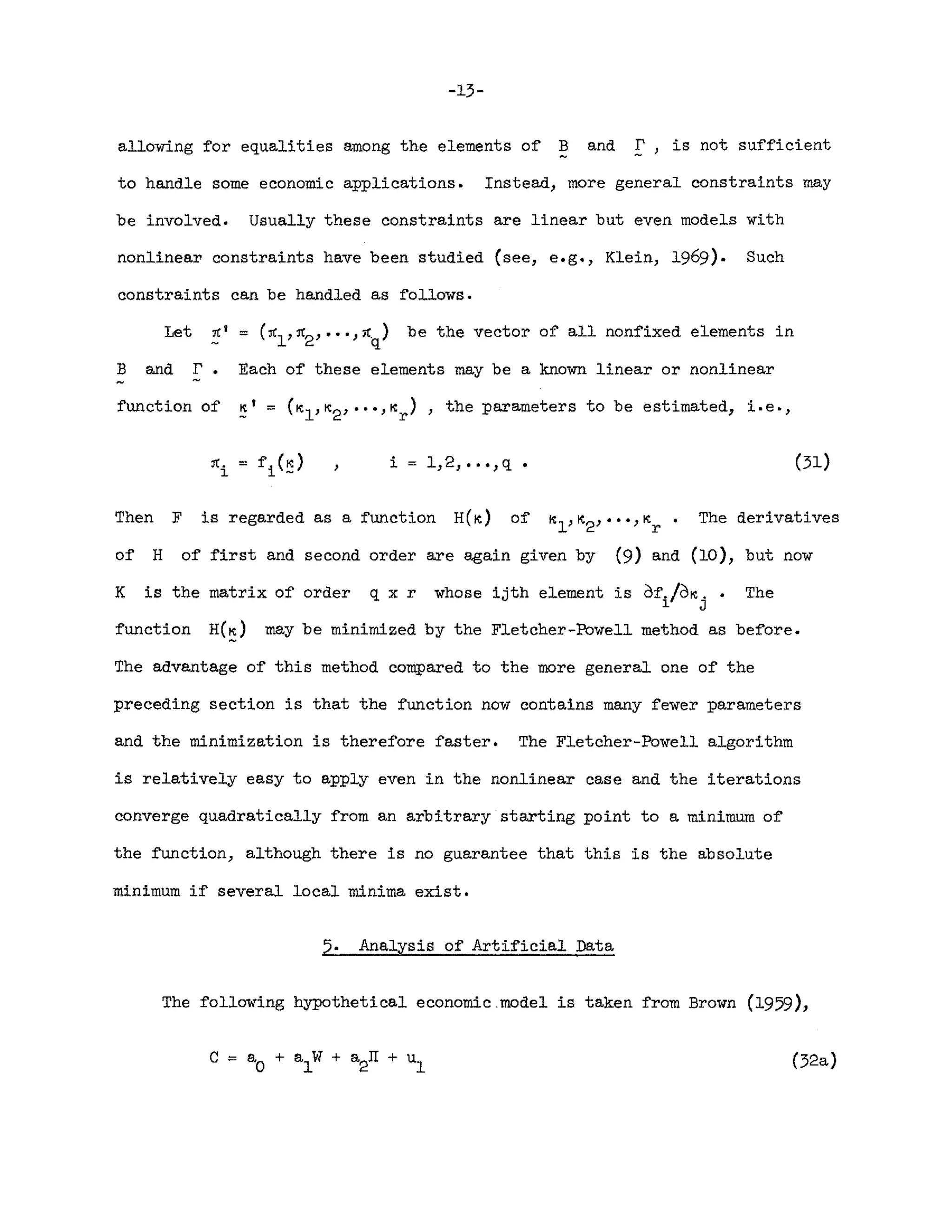
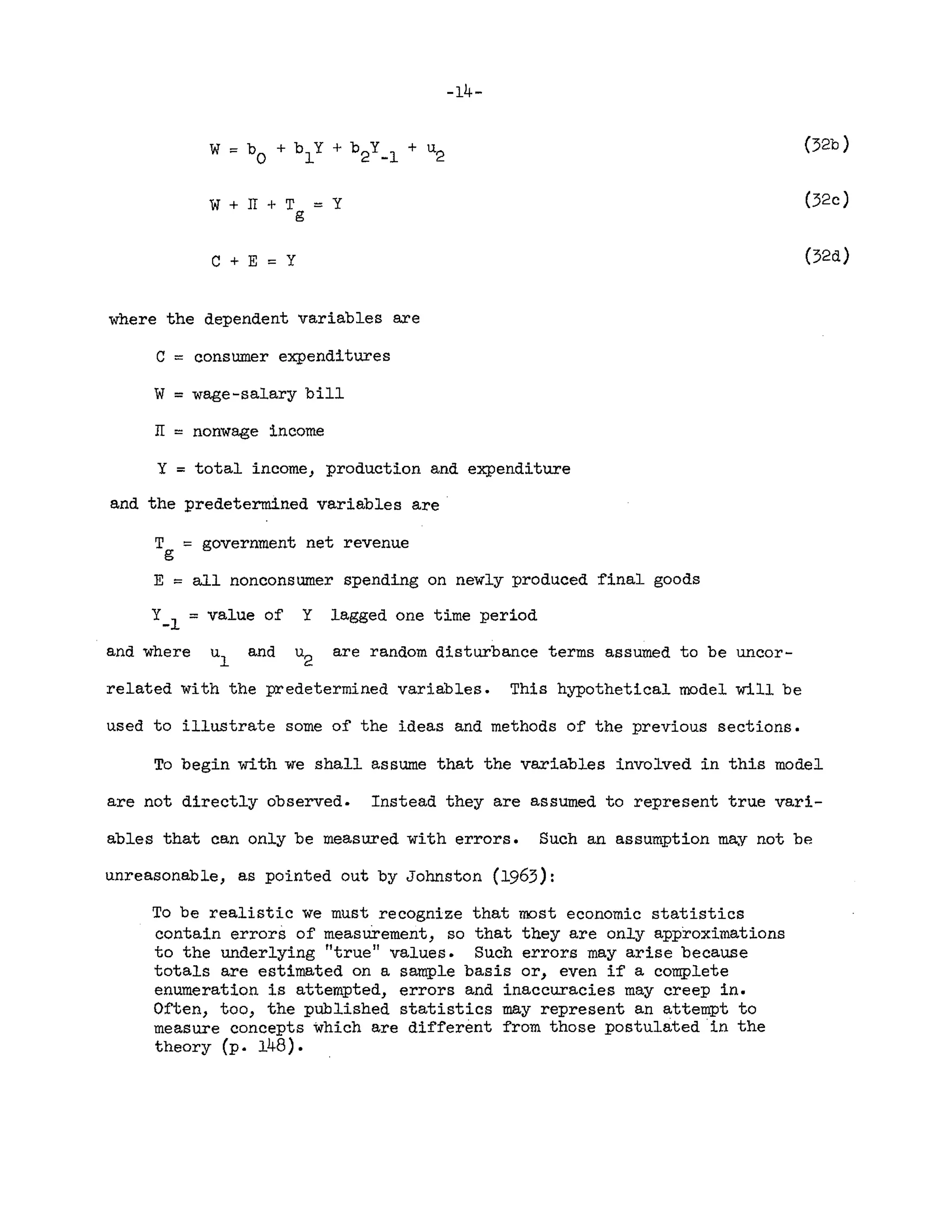
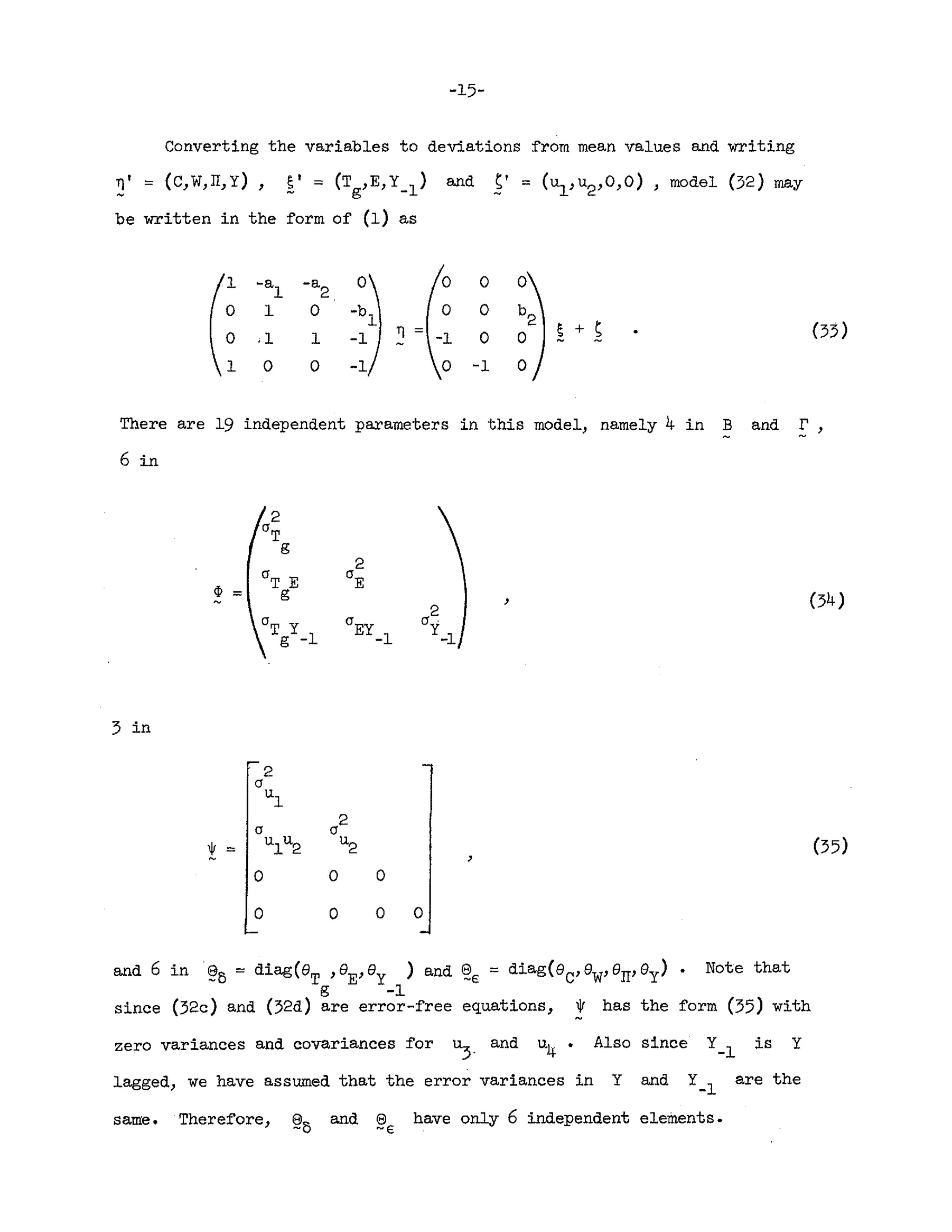
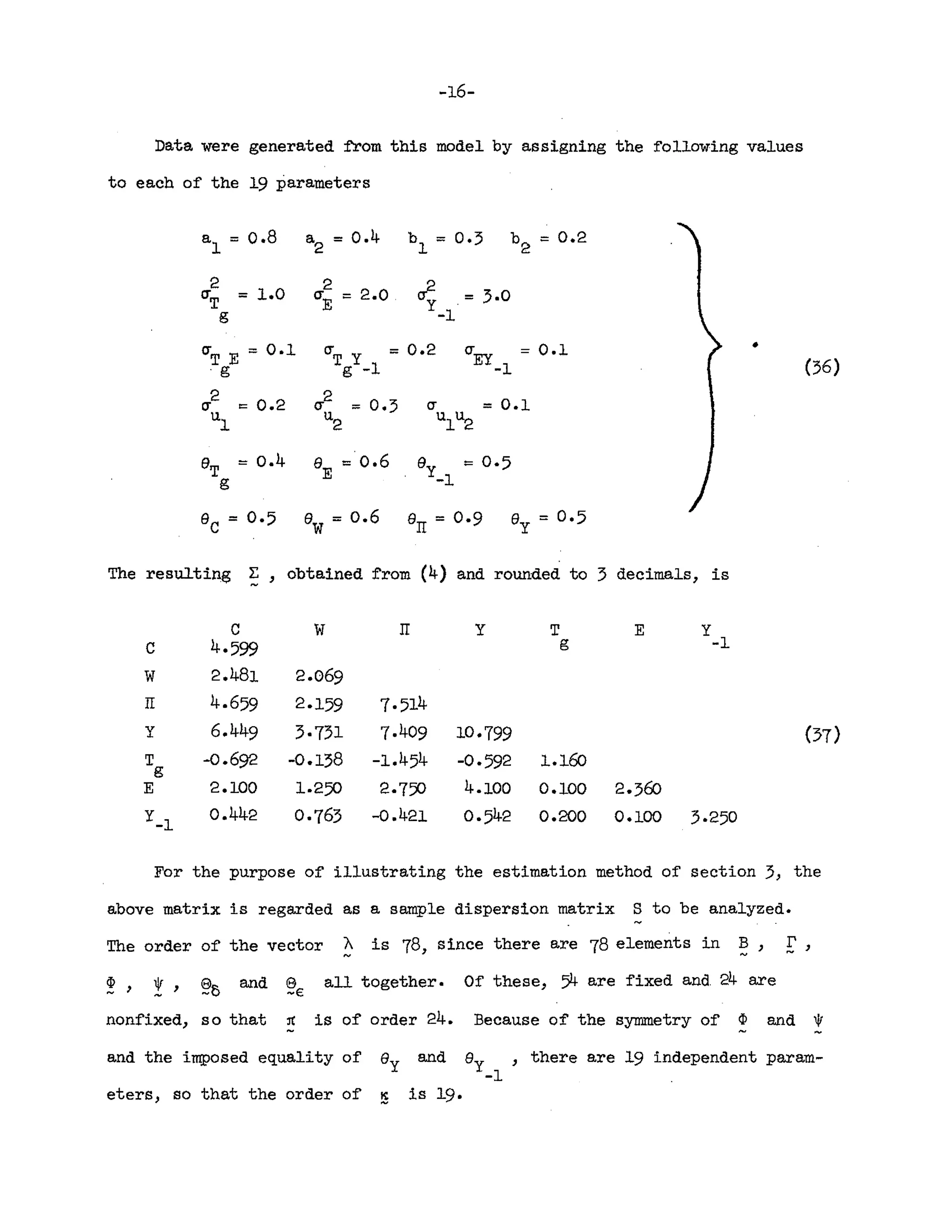
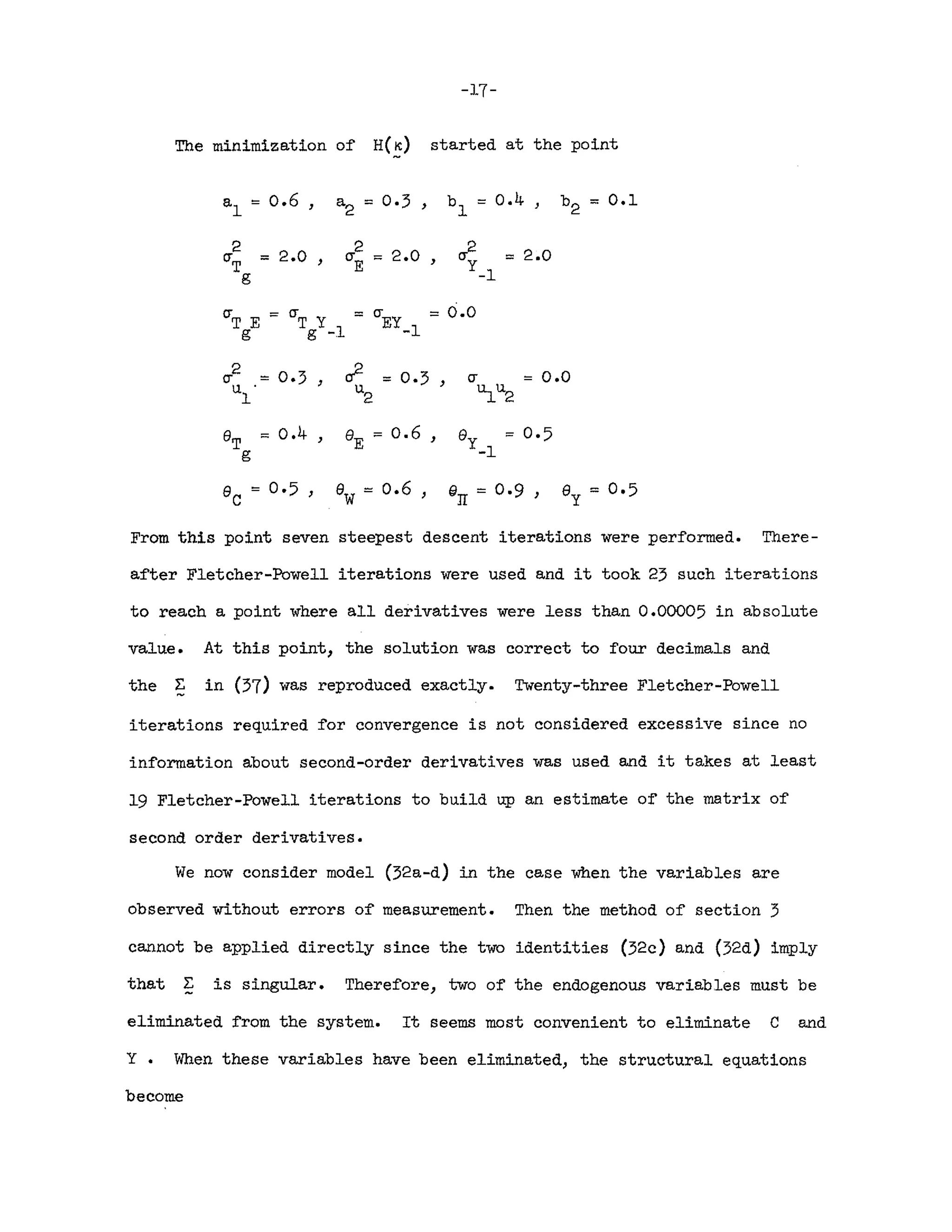
![-18-
- b
1
(58)
This system may be estimated by the method of section 4.
To illustrate the application o~ the estimation procedure we use a
dispersion matrix S obtained ~rom ~ in (37) by subtracting the error
variances from the diagonal elements and deleting rows and columns corres-
ponding to C and Y. There are 6 nonf'Lxed elements in Band !',
These elements are functions of'
namely I3U
'
o~ the vector
1312 '
:rc •
1321 ) and These are the elements
and
b2 defined by [compare equation (31)]
1311
-1 0 0 0
1312
0 -1 0 0 a
l
1321
0 0 -1 0 a
2
1
::: + (39)
1322
0 0 -1 0 b
l
0
0 0 1 0 b
2
0 0 0 1
Thus the function F is a function o~ 4 independent parameters.
The function F was'minimized using only Fletcher-Powell iterations
starting from the point
The solution point, found after 8 iterations, was, as expected, a
l
= 0.8 ,
a
2
::: 0.4) b
l
= 0·3, b
2:::
0.2 with](https://image.slidesharecdn.com/j-210629033234/75/A-General-Method-for-Estimating-a-Linear-Structural-Equation-System-20-2048.jpg)


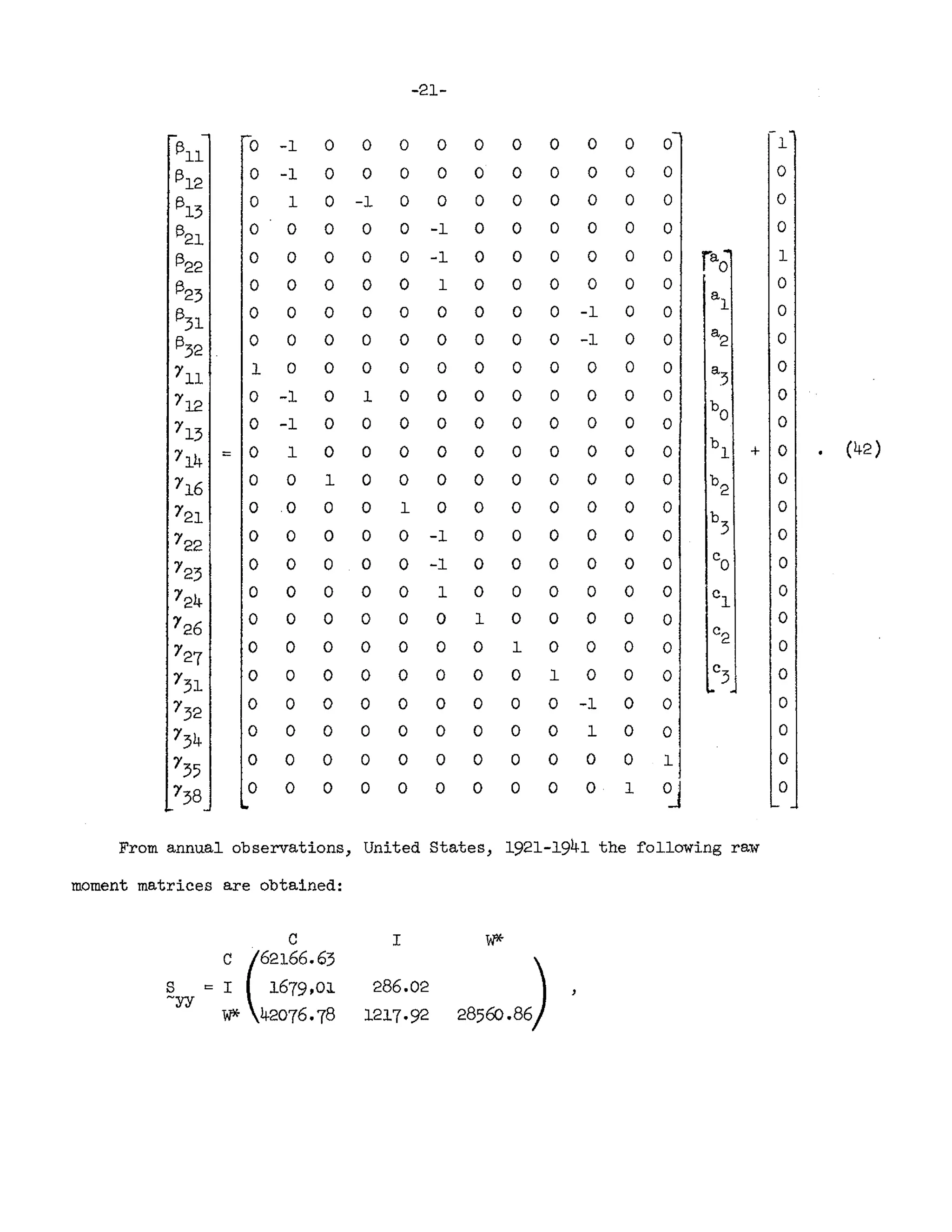
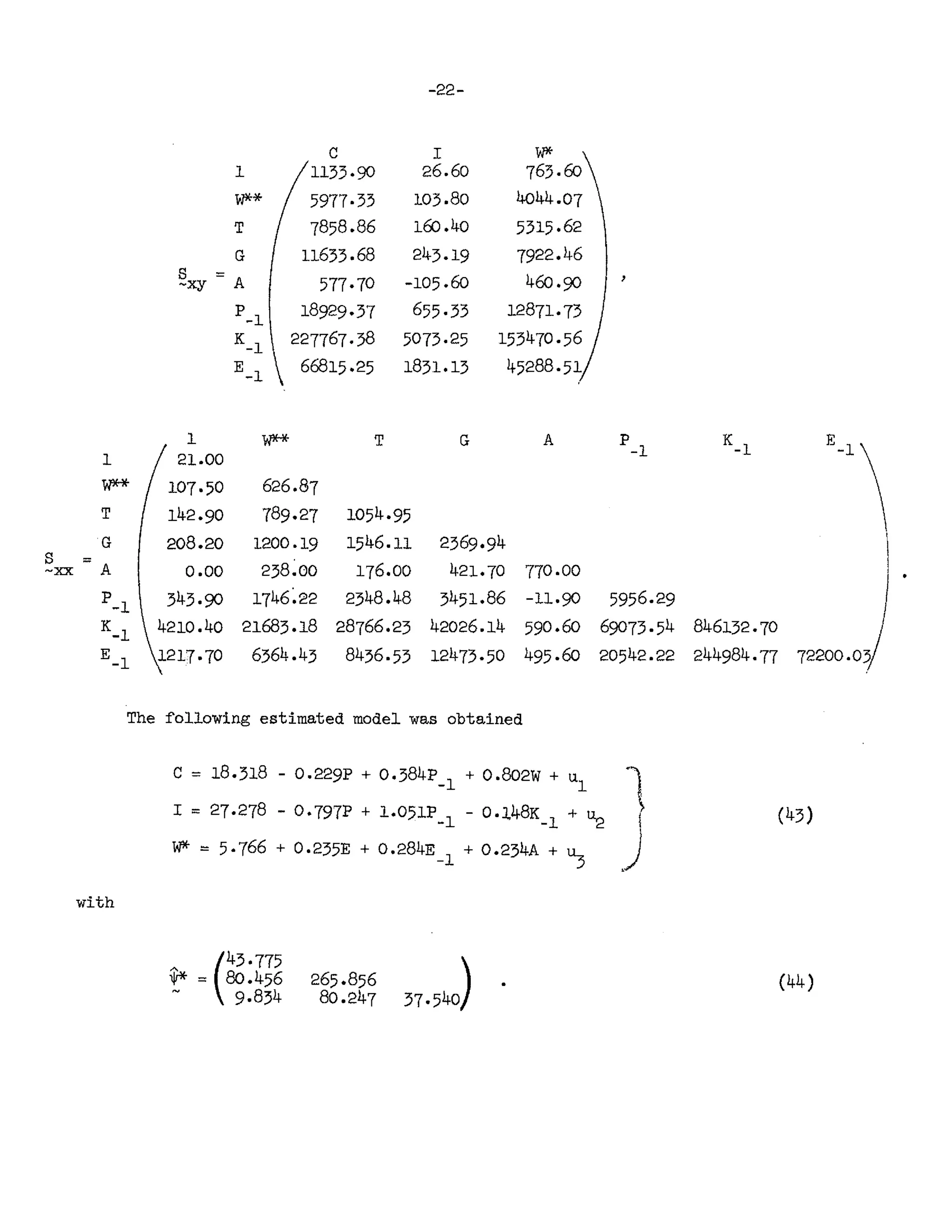
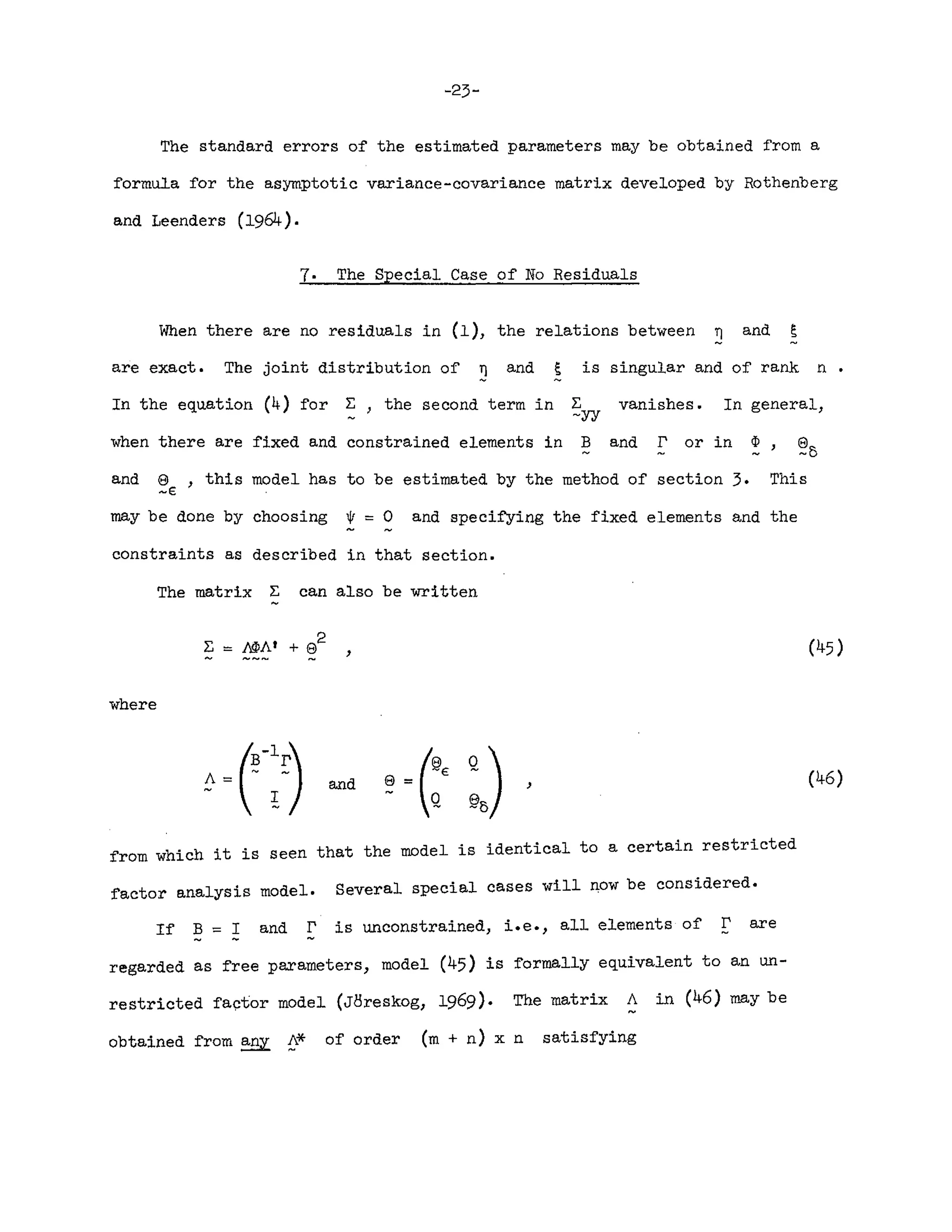
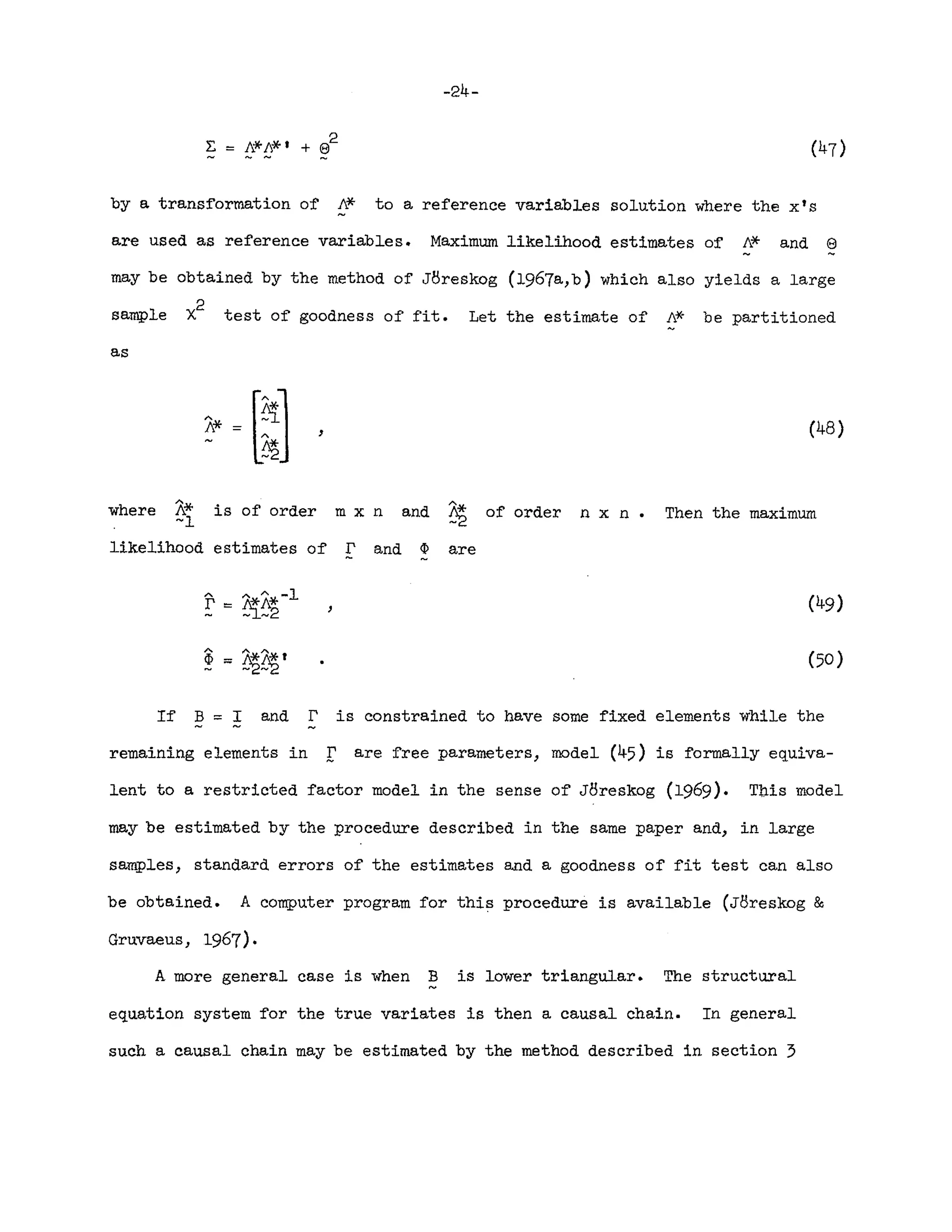
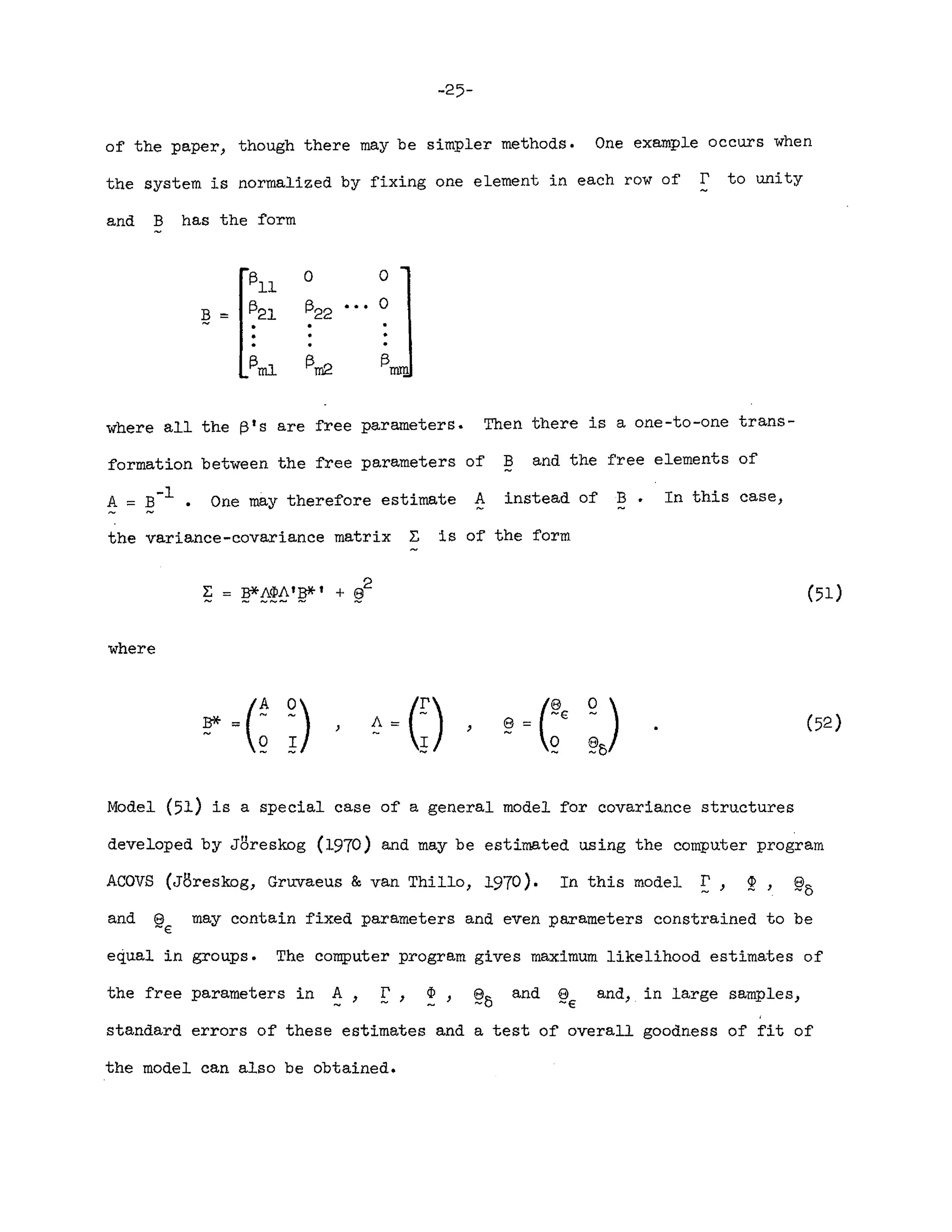

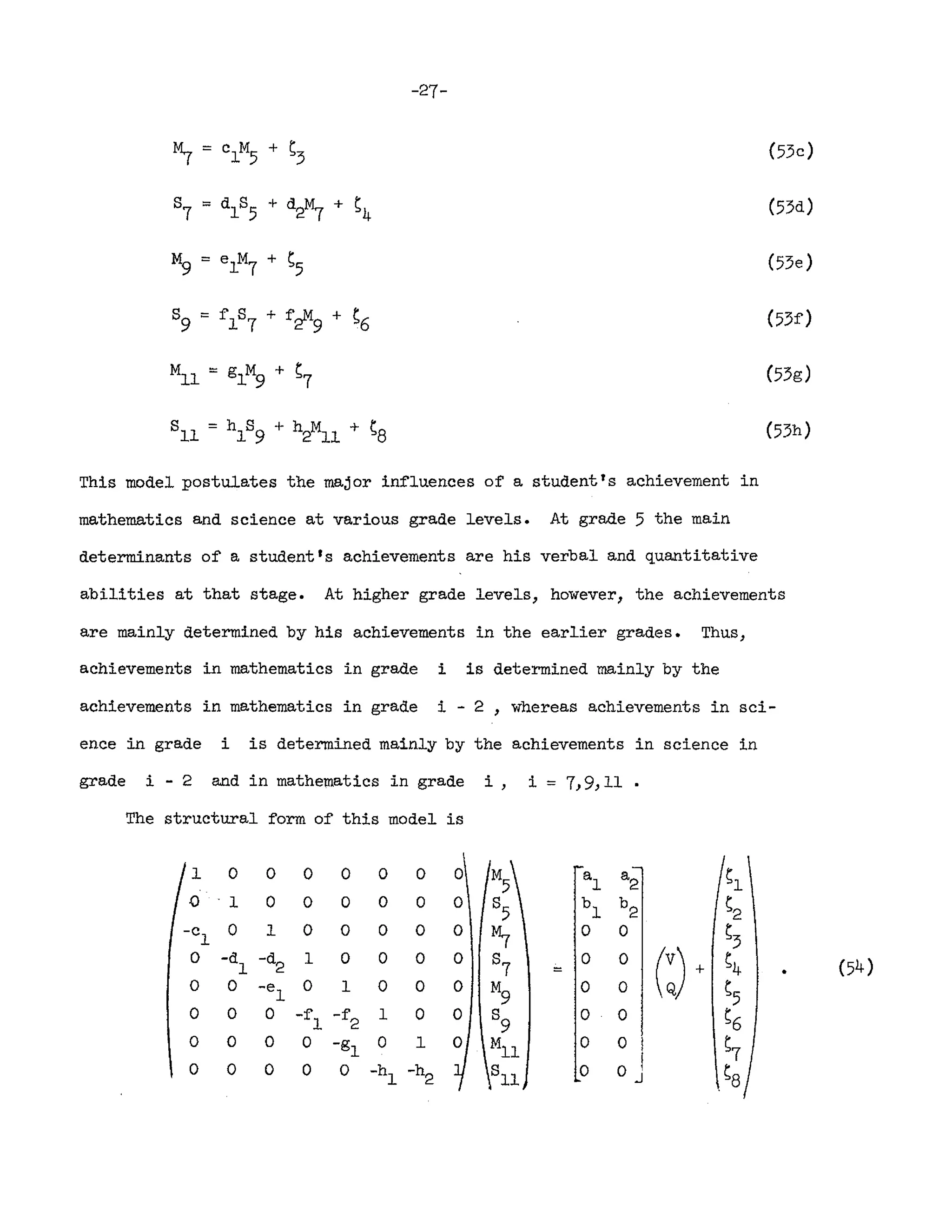
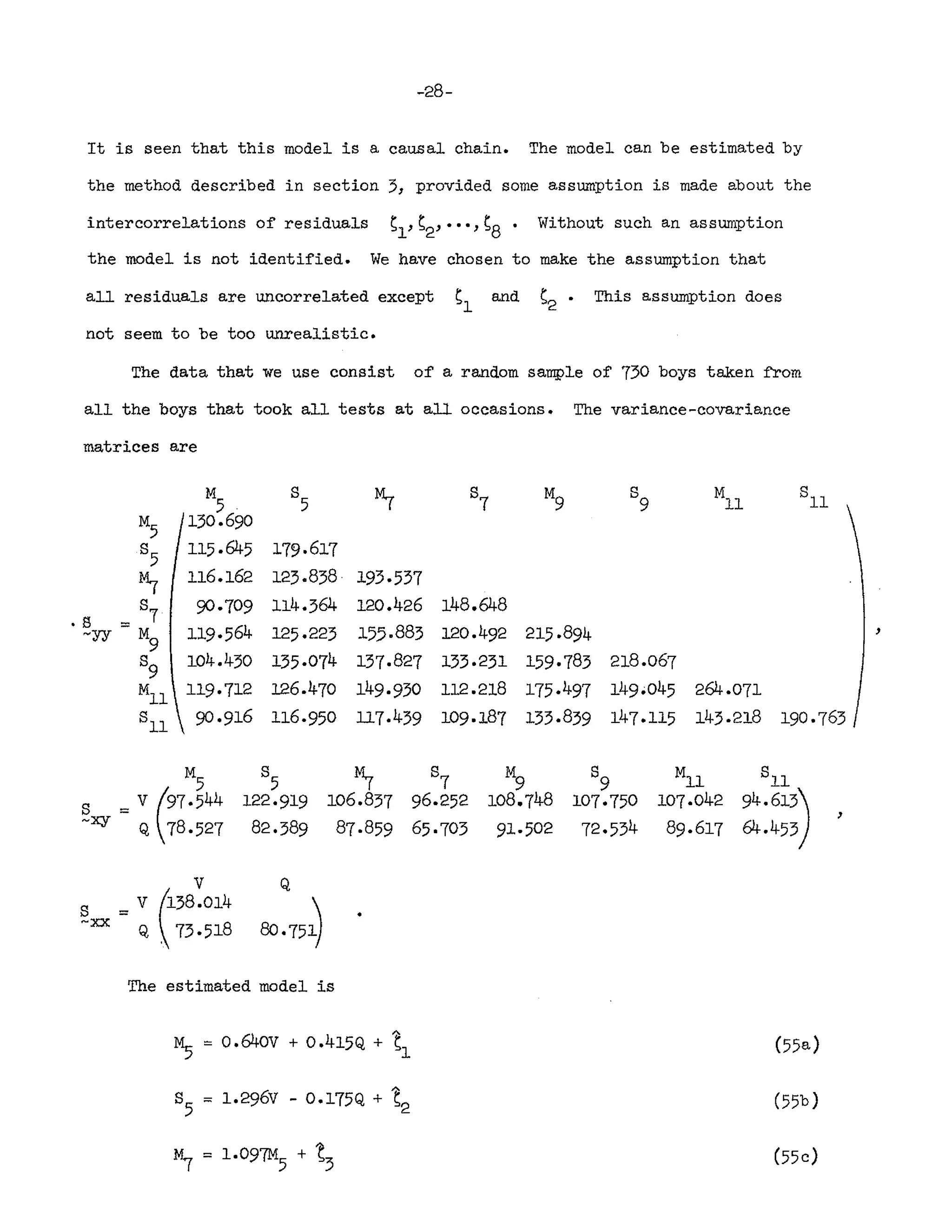

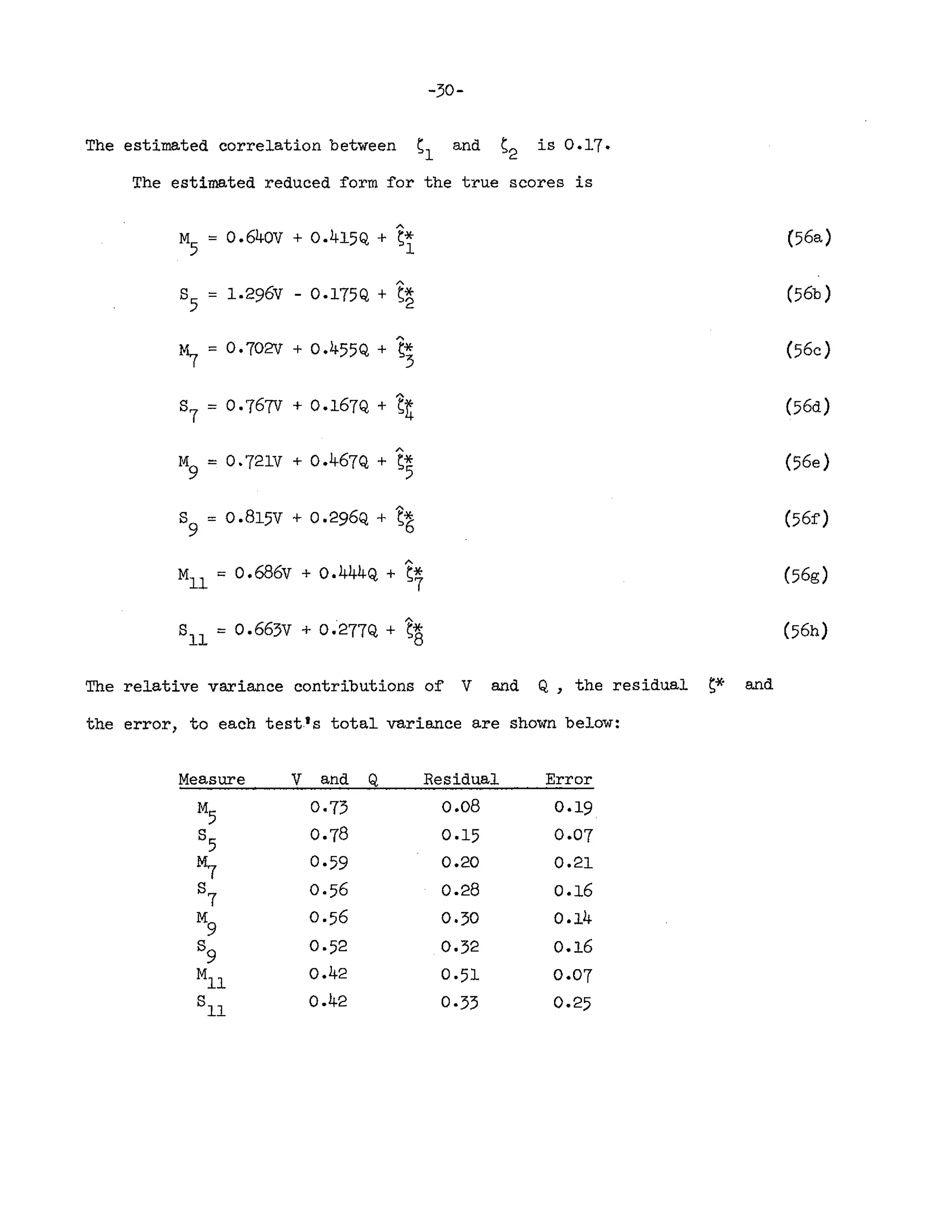

![-32-
References
Anderson, T. W. An introduction to multivariate statistical analysis. New
York: Wiley, 1958.
Anderson, S. B., &Maier, M. H. 34,000 pupils and how they grew. Journal
of Teacher Education, 1963, ~ 212-216.
Blalock, H. M. Causal inferences in nonexperimental research. Chapel Hill,
N. C.: University of North Carolina Press, 1964.
Brown, T. M. Simplified full maximum likelihood and comparative structural
estimates. Econometrica, 1959, g]j 638-653.
Brown, T. M. Simultaneous least squares: a distribution free method of
equation system structure estimation. International Economic Review,
1960, b 173-191.
Chernoff, H., & Divinsky, N. The computation of maximum-likelihood estimates
of linear structural equations. In W. C. Hood & T. C. Koopmans (Eds.),
Studies in econometric method, Cowles Commission Monograph 14. New York:
Wiley, 1953. pp. 236-269.
Chow, G. C. Two methods of computing full-information maximum likelihOod
estimates in simultaneous stochastic equations. International Economic
Review, 1968, 2." 100-112.
Eisenpress, H. Note on the computation of full-information maximum-likelihood
estimates of coefficients of a simultaneous system. Econometrica, 1962,
2£, 343-348.
Eisenpress, H., & Greenstadt, J. The estimation of non-linear econometric
systems. Econometrica, 1966, ~ 851-861.](https://image.slidesharecdn.com/j-210629033234/75/A-General-Method-for-Estimating-a-Linear-Structural-Equation-System-34-2048.jpg)
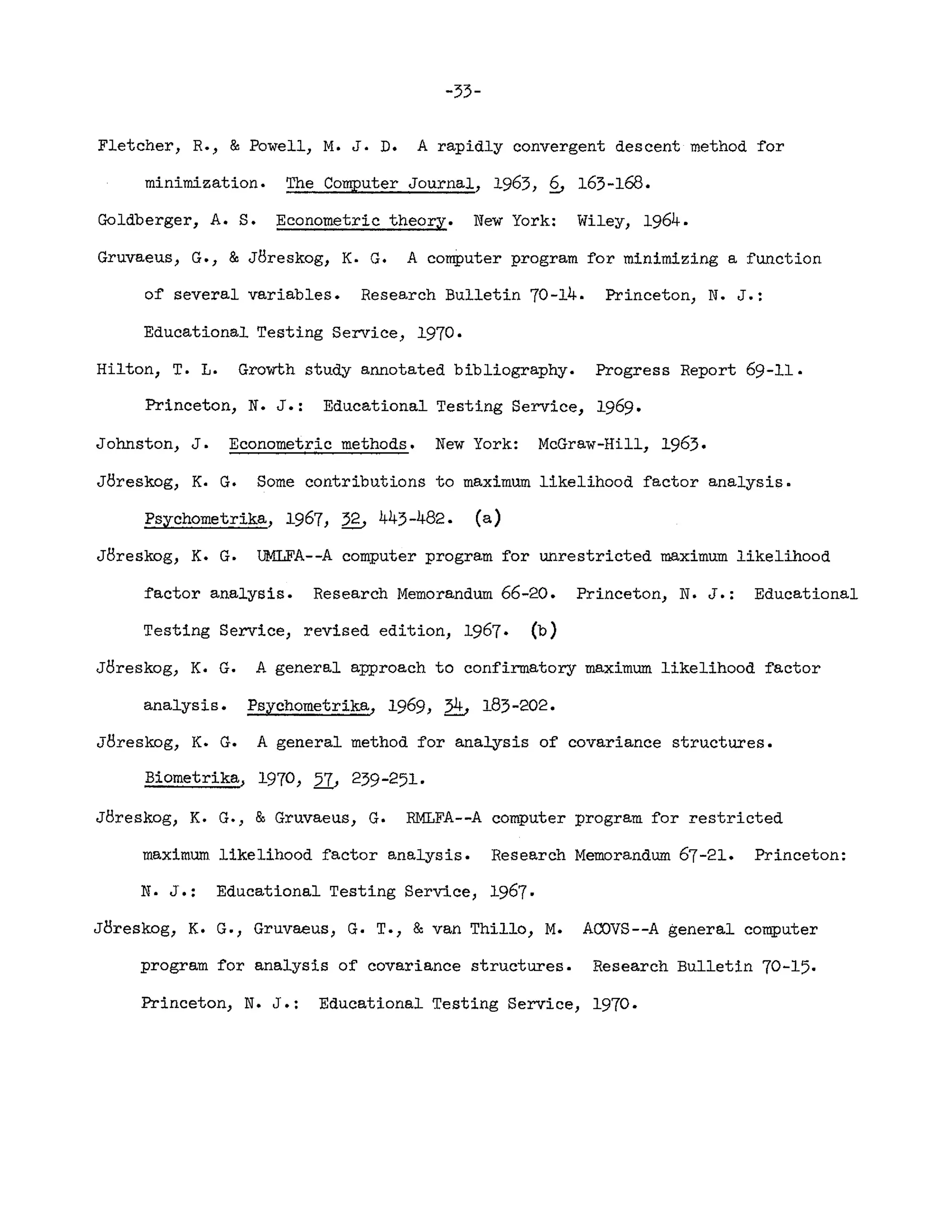
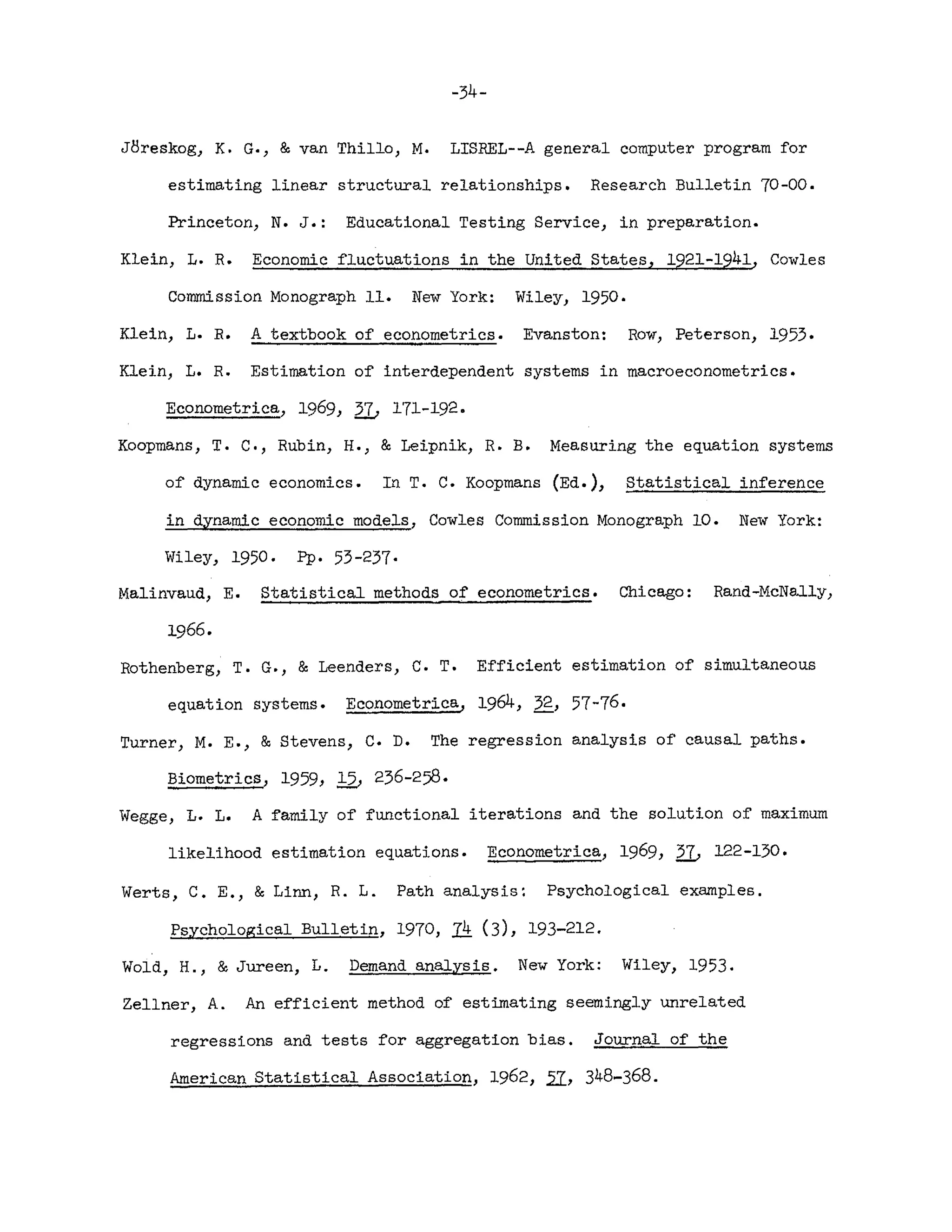
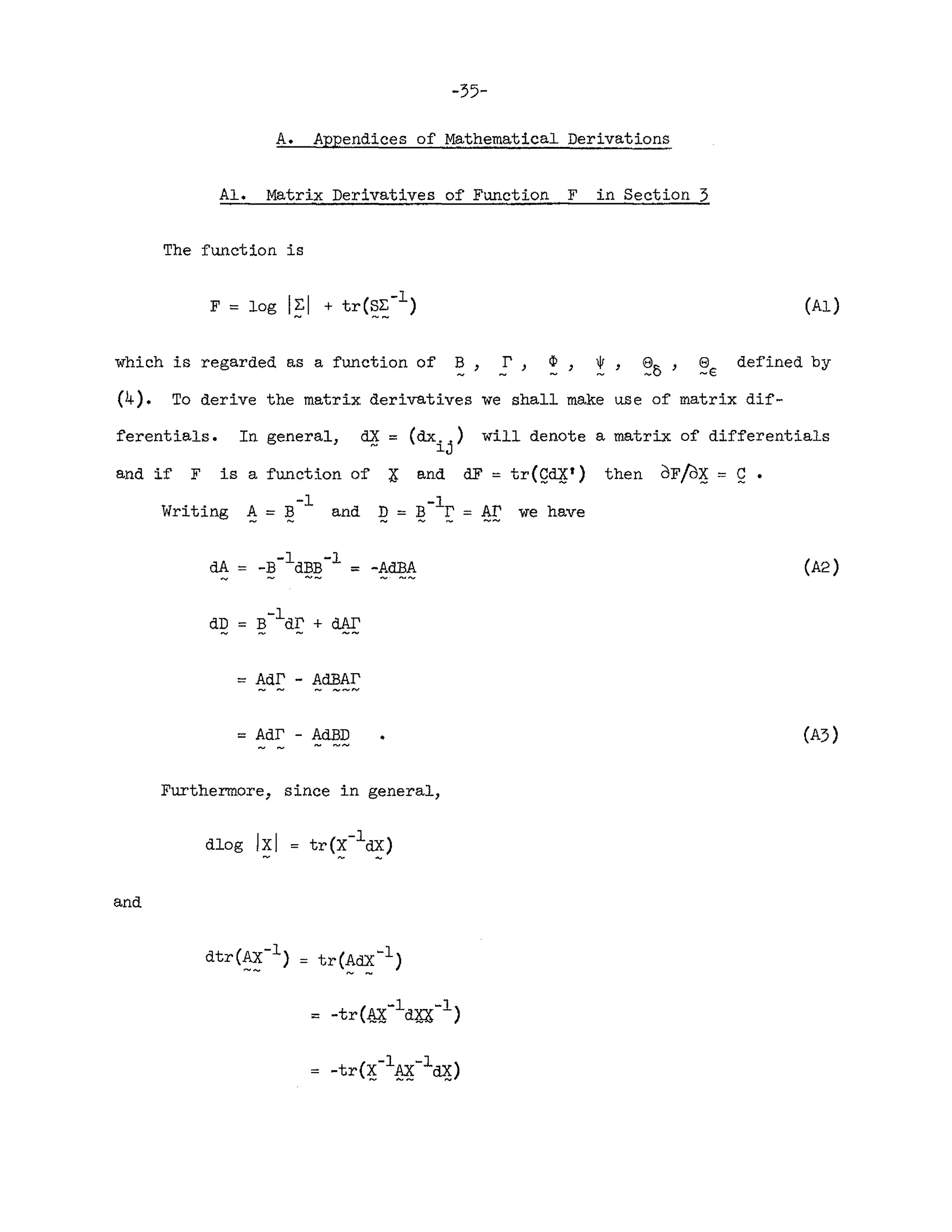
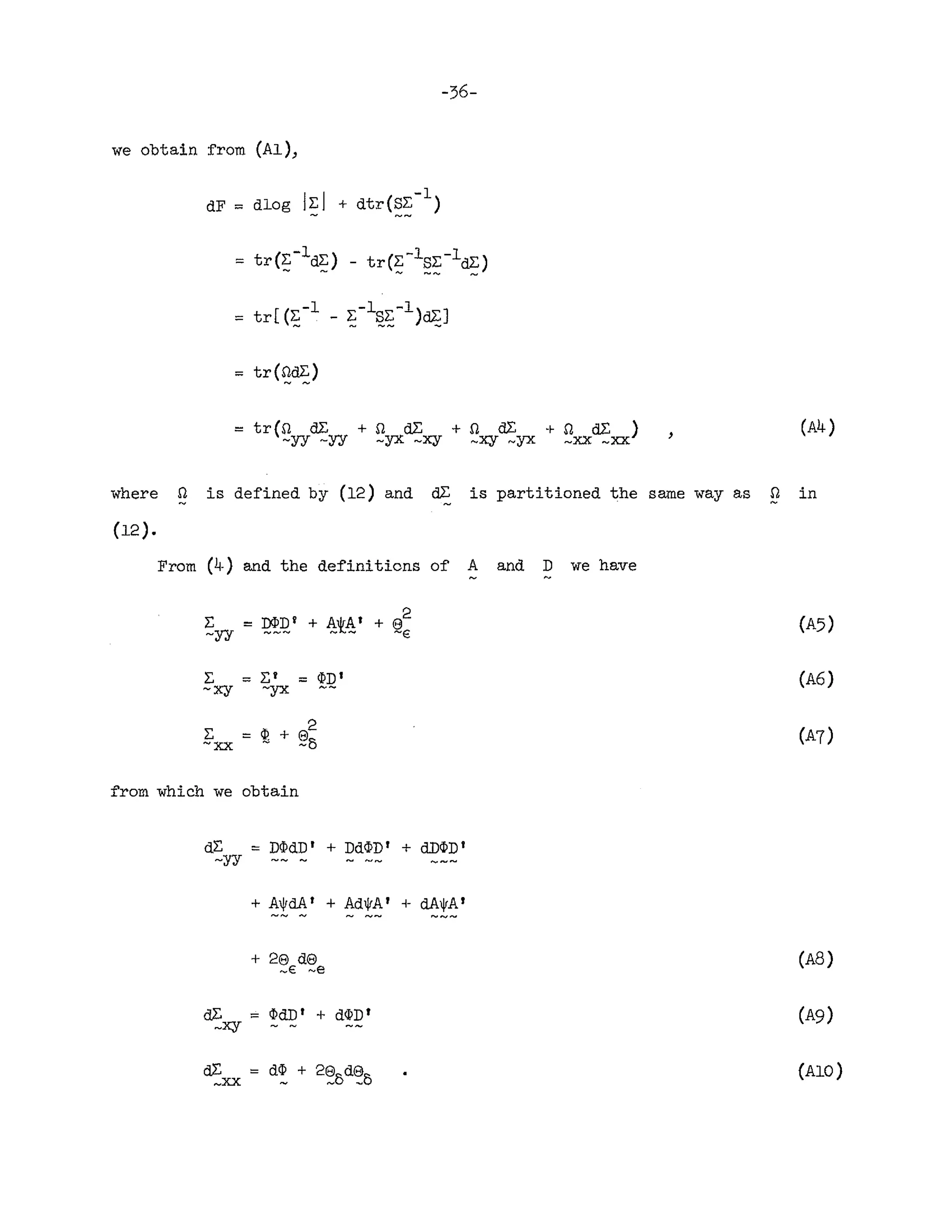
![-37-
Substitution of dA and dD from (A2) and (A3) into (AB) and (A9)
gives
+ AdI1!D' - AdB])1lD'
- A"ljrA'dB'A' - AdBA1jfAt
+ Dd<PD' + Ad1jfA' + 2e de
. -€ -€
, (All)
c1>D rdB'A' + d<!JDt (A12)
Substitution of (All), (A12) and (AIO) into (A4), noting that tr(CtdX)
= tr(~rg) = tr(2~t) and collecting terms, shows that the matrices multiplying
d!lt, dr', d~, dljr, d~8 and d@€ are the matrices on the right sides of
equations (14), (15), (17), (18) and (19) respectively. These are therefore
the corresponding matrix derivatives.
A2. Information Matrix for the General Model of Section 3
In this section we shall prove a general theorem concerning the expected
second-order derivatives of any function of the type (8) and show how this
theorem can be applied to compute all the elements of the information matrix
(12).
We first prove the following
N
Lemma: Let S = (liN) ~l (~a - ~)( ~a - ~) r ). where ~l' ~2' ••• , ~N are
independently distributed according to N(~,~). Then the asymptotic](https://image.slidesharecdn.com/j-210629033234/75/A-General-Method-for-Estimating-a-Linear-Structural-Equation-System-39-2048.jpg)
![-38-
distribution of the elements of n = E-l(E - S)~-l is multivariate
..... ..... -- ......-
normal with means zero and variances and covariances given by
(A13)
Proof: The proof follows immediately by multiplying w~ = E E ~ag(~gh - Sgh)~h~
. . g h
and w = E E ~l(~.. - s .. )crJ V and using the fact that the asymptotic vari-
I-J.V .. lJ lJ .
1 J
ances and covariances of S are given by
Ne [(cr h - s h)(cr.. - s . .)]
g g lJ lJ
(see e.g., Anderson, Theorem 4.2.4).
IT .~ • + C1 ~
gl hJ gj hi
We can now prove the following general theorem.
Theorem: Under the conditions of the above lemma let the elements of E be
functions of two parameter matrices ~ = (I-J.
gh
) and N = (Vi j
)
let F(~,~) = ~ N[logl~1 + tr(§~-l)] with OF/O~ = NAnB and
OF/O~ = N~p. Then we have asymptotically
and
( / ) ( ,2 ,I " ) -1) ( -1) ( ~'"-In) . (B! E-Ie! )h' . ( 4)
1 Ned 11) OI-J. hOv.. =(IV:, e I • B!E D h' + ~ Al
g lJ gl J gJ ].
Proof: Writing OF/OI-J.gh = Na~p)O:p'bAh and OF/Ov .. = Nc, w d . , where it
g..;:. I f-' f-' lJ ljl I-J.V YJ
is assumed that every repeated subscript is to be summed over, we have
2
(I/N)e(o F/Ojl hOY .. ) = (l/N)e(OF/OI-J. hOF/Ov.. )
g lJ g lJ
= N e(a~P)NAbA~c. w d j)
g..;:. ~ pr; au I-J.v V
= N a~bAhc. d .e(w~w )
o~ f-' ll-J. vJ "'1-" I-J.v](https://image.slidesharecdn.com/j-210629033234/75/A-General-Method-for-Estimating-a-Linear-Structural-Equation-System-40-2048.jpg)
![-39-
It should be noted that the theorem is quite general in that both M
and N may be row or column vectors or scalars and M and N may be
identical in which case, of course, ~ ~ 9 and B =D •
We now show how the above theorem can be applied repeatedly to compute
all the elements of the information matrix (12). To do so we write the
derivatives (14) - (19) in the form required by the theorem.
Let A ~ B-1 and ~ ~ ~-l~ , as before, and
T[m x (m + n)] ~ [A' 0]
P[(m + n) x m] ~~~' + ~!~J
<PD'
Q[(m + n) x n]
.(;)
~[(m + n) x n] • G)
Then it is readily verified that
dF/OB ~ -NT.I1P
dF/dr ~ NT.I1Q
dF/d(J) = NR'.I1R
(A15)
(Al6)
(A18)
(A20)
(A21)
(A22)](https://image.slidesharecdn.com/j-210629033234/75/A-General-Method-for-Estimating-a-Linear-Structural-Equation-System-41-2048.jpg)
![-40-
dF/d8 :::: Nne (A23)
In the last equation we have combined (18) and (19) using 8 ::::~o 9.
- ~ 8J
A3. Matrix Derivatives of Funct:i,on F in Section 4
The function is defined by
,
where
One finds immediately that
( -1 ) -1 )
dF :::: tr ~ d~ - 2tr(B dB
"'" "'" -"....
:::: tr[~-l(dBS Bt + BS dB' - dES r t - rs dB')]
- ~~YY- --yy - ~-yx- --x:y-.' ~
-1
- 2tr(!? d~)
,
so that the derivatives dFf2JB and dFf2Jr are those given by (29) and
- ~
()O ).](https://image.slidesharecdn.com/j-210629033234/75/A-General-Method-for-Estimating-a-Linear-Structural-Equation-System-42-2048.jpg)
